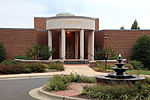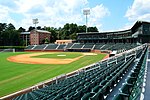The Indoor Athletic Court (commonly known as the Tin Can or the Indoor Athletic Center) was the home of North Carolina Tar Heels men's basketball team from January 8, 1924, through February 17, 1938, across fifteen seasons. Due to increased demand for viewing the varsity basketball team and limited capacity at then home court Bynum Gymnasium, the university appropriated $54,482.45 to have a structure built to house the team. Then Graduate Manager of Athletics Charles T. Woollen decided to build a temporary structure with those funds and a more permanent venue later. Plans were purchased and work began in October 1923. The building, which was a completely steel structure, was built with galvanized steel sheet siding and roof. Many felt the building did not have an attractive exterior. The building featured one bathroom, no locker or dressing rooms, and no heating system, initially. Quickly the building earned a reputation for being cold during the winter and hot during the summer time. An official heating system and, later individual heaters, were added to the building, but did not help the temperature problem. The men's basketball team moved to the Woollen Gymnasium in 1939.
During their time in the Tin Can, the Tar Heels won several Southern Conference championships: six regular season titles and four conference tournament titles. Aside from basketball the building was used for many other sports including: wrestling, fencing, and boxing, among others. It hosted the Southern Indoor Track and Field Games for the Southern Conference for nine years. Outside of athletics, the Tin Can was the site of many class picnics, school dances, class registration, and concerts. In the 1930s and 1940s, the building hosted several big bands and artists including Frank Sinatra and Tommy Dorsey. Following the basketball team's departure, students continued to use the facility for sports, while adjustments were made to allow for volleyball and golf. After World War II, the building was used as a temporary dormitory for around 275 students. When a structure was announced to be built in the Tin Can's location in 1976, the university's trustees weighed the costs of moving the existing structure to the east end of Fetzer Field or tearing down the Tin Can and building a replica in the aforementioned location. Ultimately, the structure was torn down and a new one built on Fetzer Field. In total, the university used the temporary building for 54 years.











